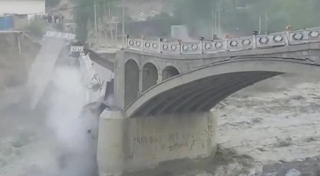Climate Change's Impact on Pakistan's Gilgit Baltistan and glacier marriages
Impact of Climate Change
With its impact on the water industry, biodiversity, and forests, climate change and its repercussions may be seen all over the world. It has an impact on our health as well as our socioeconomic situation. According to a research published by the Intergovernmental Panel on Climate Change, underdeveloped and poorly developed countries are more vulnerable to the consequences of climate change. When a climatic calamity strikes in such a location, the poor are disproportionately affected due to a lack of information and resources. Human-made activities, or anthropogenic activities, are the primary cause of such climate-related calamities, and low-wage workers are disproportionately affected. The emission of greenhouse gases and the usage of fossil fuels
The recent Shisper glacial outburst and subsequent damage to the bridge in Hunza's Hasan Abad valley, which once again blocked the Karakorum Highway, underscored the need of working on preventing the negative effects of climate change. Climate Change is posing a serious threat to the ecology and atmosphere, particularly in Pakistan, which is one of the top ten countries most affected by the phenomenon. Due to climate change, Gilgit Baltistan in particular is suffering a double-edged sword: intense cold and abundant snowfall in the winters, and glacial outbursts and flooding in the summers.
Prevention of Melting Ice, Glacier Grafting
Glacier growing, also known as artificial glaciation or glacier grafting, is a technique used in the Gilgit Baltistan's regions to create small new glaciers in order to boost water availability for crops and, in certain situations, to support micro hydro power. Local farmers obtain ice from naturally occurring glaciers and transport it to high altitude places, where it is placed within a small cave cut out of a scree-slope to induce glacier formation. Other components such as water, salt, sawdust, wheat husks, and charcoal are also placed at the site along with the ice. Glacier grafting is an ancient skill practised by mountain farmers in Gilgit Baltistan, where it has been utilised for irrigation.Locals in Gilgit Baltistan use an ancient technique for glacier grafting, which has been supplemented by certain modern breakthroughs, to establish long-term water sources.
Grafting a new glacier necessitates a nearly 1 mann piece of each of the "male" and "female" glaciers. Villagers carefully stack these pieces into a hand made bucket with coal and barley hay to keep them safe from the warmer temperatures.Then they move it to the appointed location, cover it with a mud, ash, and charcoal mixture, and bury it with large stones.
Time later it becomes expends day by day and becomes a mountain of ice and called as Glacier.








Post a Comment